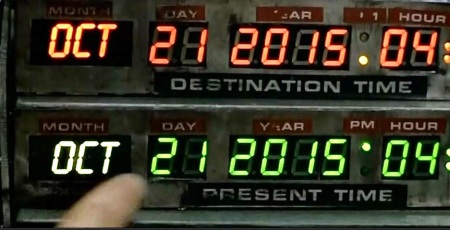Welcome to the Future of 2015

The day has finally arrived. October 21, 2015. No, it is not another Maya prediction. Today, we are finally at the point in time to which Marty McFly (Michael J. Fox) travels in Back to the Future Part II

Though I don't expect the time-space continuum to collapse today or to find Marty, Doc, and Jennifer visiting us, I do expect to see them in the media.
Watch the trailer for that film and refresh your memory. A number of news reports have covered what the film got right and wrong about this future that is our present - including its prediction of a Cubs World Series win.
I'm not too concerned that we don't have Marty's self-tying shoes yet (though Nike has a real-life experimental version). And the filmmakers did miss out on predicting the Internet and mobile phones (but so did most futurists). We have been anxiously waiting for flying cars for about a hundred years and people keep trying to make Marty's hoverboard. But the film series did predict things like computerized fueling stations (though not robotic yet) and non-military drones.
The predicting business is tough. In many cases things predicted in sci-fi came true, but it took a lot longer than expected.
In Marty's Hill Valley hometown, the theaters are showing in October 2015 Jaws 19, in 3D, directed by Max Spielberg. Thankfully, the Jaws franchise was killed by the actual 3D third film. Max Spielberg (Steven's real-life son, born in 1985) has worked on a few films, but no directing. That gag seems a lot more like an insider director joke than a prediction. (After all, Steven Spielberg produced the film.) They are right though - Hollywood is in love with sequels and franchises in 2015.
We are actually scanning eyes and fingerprints for identification as they do in the film. It's on your iPhone but not ubiquitous in our homes. I still have a boring doorknob instead of the McFly family's scanner.
We have advanced more into being paperless than the film shows. The USA Today there is quite a thick stack of paper and the film likes using fax machine devices which probably are only used by government agencies these days. Marty's dad gets terminated from his job in a video call that is confirmed by a printout that looks like it was done on a dot-matrix printer using Print Shop.
Some observers have pointed to Google Glass and Microsoft Hololens as versions of the different high-tech eye-wear in the film with cameras, magnification, information and some bluetoothy way of connecting.
The film's 2015 is having a bit of a nostalgic love affair with the 1980s. That allows the set decorators to use their contemporary props, like a Macintosh computer and a dustbuster vacuum, as collectible items of the future. Marty visits a Cafe 80s where 1970s jeans, NY Yankees t-shirt and Chuck Taylor sneakers would not seem out of place. Future fashions in films always seem to be metallic, unisex and either very odd or more like uniforms - but those fashions never seem to emerge. I think you're safer predicting that the future will look more like today than going over to the other extreme.
The filmmakers had Marty using cash to buy things in 2015, and even with all our credits cards and merchants experimenting with alternate ways of paying, a $20 bill still works just fine.
Inventor Doc Brown says that he had some life-extension procedures - a full blood transfusion, hair repair and a new spleen and colon – and I have always suspected that rich people were doing those things already. Those procedures help Doc (Christopher Lloyd) look a bit younger in the 1990 Back to the Future Part III
The movie missed our 2015 penchant for watching video on small screens. It does provide plenty of big flat-screens on walls with multiple channels displayed, and as advertising and even on window blinds. No Internet in the film but the McFly family does use a big screen AT&T-connected device for video calls that looks like our Facetime/Skype/Hangouts kind of video conversation. The screen also carries data about the caller (names of children, hobbies, food preferences) which have been part of the database facial recognition being built into devices these days.
This post and related ones first appeared on Weekends in Paradelle
Trackbacks
Trackback specific URI for this entryThe author does not allow comments to this entry
Comments
No comments